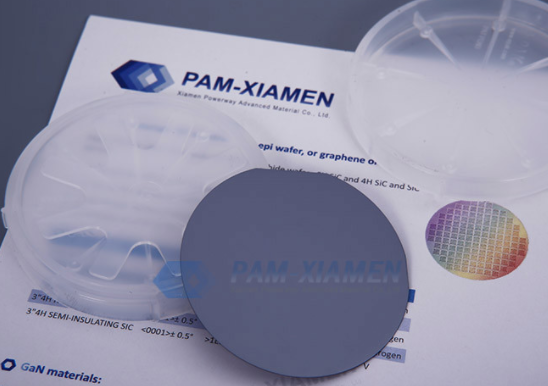The typical structure of InAs quantum dot (QD) layers on InP substrate is available with wavelength of 1.55um for QD photodetector. Quantum dot is called semiconductor nanocrystals (NCs), which refer to three-dimensional constrained nanomaterials with a radius smaller than or close to the exciton Bohr radius. And colloidal quantum dots (CQDs) have obvious quantum confinement effects in the field of optoelectronic applications and can provide a process platform for liquid-phase processing devices. Quantum dot is the basis for building low-power and high-performance photodetectors and is a new candidate material for developing a generation of high-performance electronic devices. Following is the epitaxial structure with InAs/InP quantum dot:

1. InP Epitaxial Wafer with InAs Quantum Dot
| Material | Thickness |
| i-InP | 100nm |
| InGaAsP or InP | – |
| InAs | QDs |
| InGaAsP or InP | – |
| i-InP | 200nm |
| SI-InP Substrate | – |
The InAs/InP external cavity quantum dot laser working in a 1.55μm window is an important component of wavelength division multiplexing in optical fiber communications.
2. About InAs Quantum Dot Growth
So far, a variety of methods have been developed to prepare QDs materials, which can be roughly divided into two categories: one is the “top-down” method, and the other is the “bottom-up” method.
The “top-down” method usually uses traditional etching techniques to transform large-scale materials into nano-scale QDs. And electron beam lithography, reactive ion etching, and wet chemical etching are commonly used to prepare II-V and II-VI semiconductor QDs. Electron beam lithography can flexibly engrave nano-scale patterns, design and fabricate nanostructures. In this way, the precise separation and periodic arrangement of QDs, lines and loops can be achieved. In addition, focused ion beams can be used to make quantum dot array. The shape, size, and particle spacing of quantum dots are related to the beam diameter of the ion beam.
According to different self-assembly technologies, the “bottom-up” method can be divided into gas phase synthesis method and vapor deposition. Vapor deposition method is widely used for quantum dot synthesis, usually including thermal evaporation, chemical vapor deposition, laser ablation, molecular beam epitaxy and other technical means.
Many studies have shown that it is still a problem to obtain self-assembled quantum dots with orderly arrangement and uniform size.
3. Development Status and Application of Quantum Dot Technology
With the progress of laser, electronic and photonic integrated circuits, optical interconnection and modulation technology, today’s society can enjoy the convenience brought by broadband, high-speed Internet and mobile network connection. An obvious relationship between the height of quantum dot and thickness of InP deposition is found by the experiments of photo luminescence and transmission electron microscopy. An improved cap growth method can obtain 1550nm wavelength and narrow spectral line width in InAs/InP quantum dot distributed feedback lasers. In addition, the quantum dot supports the fabrication of devices with emission in 1.5um range.
However, with the rapid increase of energy demand and bandwidth demand, the ultra-compact technology needs to further innovate in electronic and photonic integrated circuits. In optics, laser technique based on QDs surpasses the technology based on quantum well (Qwell), making great progress. The laser diode and optical amplifier fabricated on wafer with uniformly grown InAs quantum dot film will become the main product for future energy-saving information communication technology and optical fiber for information transmission.
For more information, please contact us email at victorchan@powerwaywafer.com and powerwaymaterial@gmail.com.

